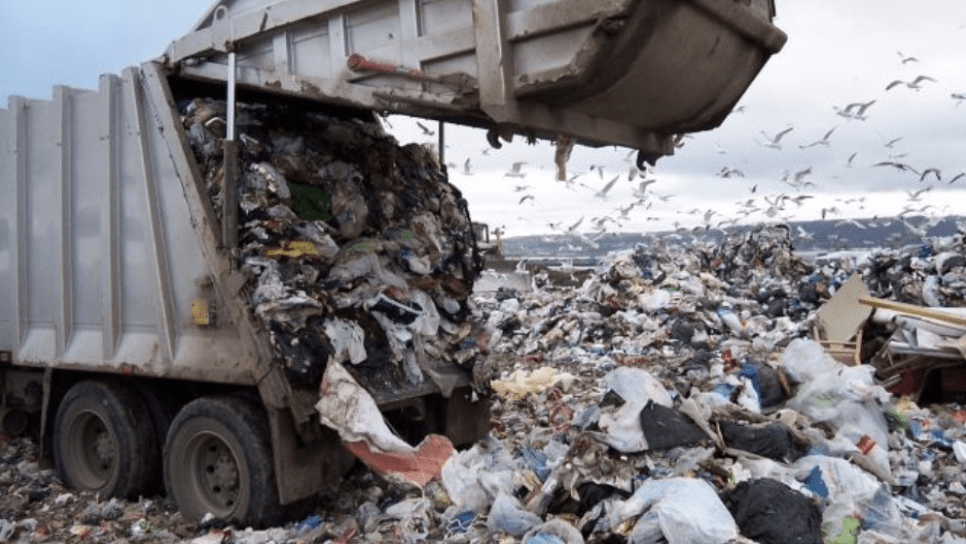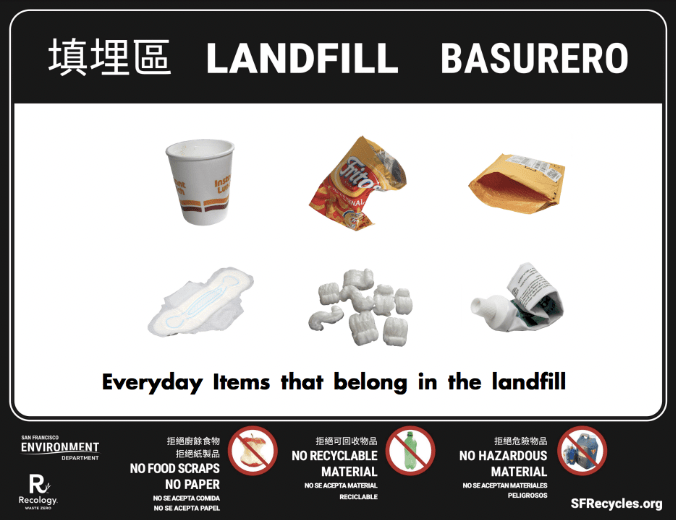Oops! You Accidently Dropped 102 Tons of Trash on the Ground
 The idea of waste is a man-made construct; no other being creates byproducts that cannot be naturally recycled by this Earth. The creation of “waste” and landfills, aligned with terms like “throw away,” create a disconnection between people and the waste they produce, giving the perception that once we are done with something, it no longer exists. Things thrown away do not simply go away; oftentimes they can last in the landfill longer for the length of their use. Toothbrushes are only recommended for use for three months, yet the average plastic toothbrush takes 500 years to fully degrade in a landfill. The plastic films and wraps on all packaging you’ve ever touched still exist since plastic takes a tremendously long time to fully break down. The United Nations cites their degradation range from 20 years to 500 years, as they begin the process after a couple decades but can take hundreds of years to decompose. Even then, however, the plastic does not fully decompose, it just gets broken down into smaller and smaller pieces.
The idea of waste is a man-made construct; no other being creates byproducts that cannot be naturally recycled by this Earth. The creation of “waste” and landfills, aligned with terms like “throw away,” create a disconnection between people and the waste they produce, giving the perception that once we are done with something, it no longer exists. Things thrown away do not simply go away; oftentimes they can last in the landfill longer for the length of their use. Toothbrushes are only recommended for use for three months, yet the average plastic toothbrush takes 500 years to fully degrade in a landfill. The plastic films and wraps on all packaging you’ve ever touched still exist since plastic takes a tremendously long time to fully break down. The United Nations cites their degradation range from 20 years to 500 years, as they begin the process after a couple decades but can take hundreds of years to decompose. Even then, however, the plastic does not fully decompose, it just gets broken down into smaller and smaller pieces.
Landfills are becoming full of materials that will not decompose over time, taking up land space and polluting the natural spaces around them. Toxins can leach into the ground and spread throughout the soil, contaminating its health and damaging the vegetation. These toxins can also continue to leak, spreading all the way into bodies of water, causing damage to marine ecosystems as well. The most pressing environmental issue from landfills comes from the release of heat trapping greenhouse gasses into the atmosphere, including nitrous oxide–which also contributes to smog–and methane. Methane is a huge contributor to global warming as it is one of the most potent greenhouse gasses, absorbing heat from the sun eighty-four times more than carbon dioxide.
Methane is a gas produced as organic materials decompose in an anaerobic environment. Microbes will find any organic materials left in the landfills, which is primarily food waste but also other organic waste such as wood, grass, and flowers. These microbes will eat this waste and produce methane gas in the process. In the natural environment, these microbes serve an essential purpose of regulating a gas cycle within the system, particularly in the deep sea (Khanna, 2022). In a landfill, these microbes are not in their natural ecosystem, causing an overproduction of methane with no way to balance it.
The best way to lessen the production of greenhouse gasses, especially methane, is to ensure that no food waste (or any organic waste) enters the landfill! San Francisco’s waste collection service, Recology, has an extensive composting collection system in place, making it easier for residents to sort their trash. While San Francisco leads big cities with zero-waste initiatives, there is still a ways to go in creating a more sustainable relationship with waste and landfills. San Francisco manages to divert 80% of solid waste from landfills each year, equating to about one and a half million tons (Brigham, 2018). In a 2018 interview by Katie Brigham of CNBC, the director of San Francisco’s Department of the Environmental, Debbie Raphael, said that 60 percent of what ends up in San Francisco’s trash bins could be composted or recycled. This city diverts 80% of waste from landfill, compared to the national average of 35% (MacBride, 2013), yet still over half of San Francisco’s waste that ends up in landfills does not belong there.
The landfill is commonly considered as the default place where most waste should end up. However, only a very small percentage of the waste stream truly belongs in the landfill. Colloquially, what goes in the landfill is defined as anything that does not go in the recycling or compost bins, but this mentality contributes to overfilled landfills along with all of the consequent environmental damages, as anything in the “unsure” category often ends up defaulted to the landfill. In San Francisco’s gray or black landfill bins, there should be: soft plastics, styrofoam, rubber, adhesives, sponges, dental floss, fabrics that cannot be used or donated, and items such as pens and pencils, which have many mixed materials that cannot be separated for recycling (Recology, 2024).
 There are also many items that do not belong in the recycling, compost, or landfill because they need more specialized proper disposal. These items include electronic waste, batteries, undried paint, leftover household cleaners, any product containing mercury, tires, medical waste, large pieces of styrofoam, light bulbs, appliances, furniture, textiles, and pesticides.
There are also many items that do not belong in the recycling, compost, or landfill because they need more specialized proper disposal. These items include electronic waste, batteries, undried paint, leftover household cleaners, any product containing mercury, tires, medical waste, large pieces of styrofoam, light bulbs, appliances, furniture, textiles, and pesticides.
The main reason why many of these items are banned from the landfill is because they can create a harmful reaction in which they release toxins into the environment. For example, batteries contain many hazardous chemicals that release into the environment when they corrode. Pesticides and household chemicals are harmful enough on their own, but in the landfill they interact with each other along with other materials, causing the release of even more harmful compounds. Additionally, many of these materials do not belong in the landfill because they have the potential to be recycled and simply need special care. Styrofoam is a harmful finite packing material, so Recology tries to catch and recycle as much of it as possible to avoid the production of new styrofoam. While small, broken pieces are hard to catch and should be landfilled, large whole pieces should be brought directly to Recology’s (or your respective municipal waste management company’s) collection site. From there, styrofoam can be repurposed or even remade into materials such as crown molding, picture frames, and deck flooring.
The landfill is not the default bin. Treating it as such has detrimental consequences as it causes environmental damages. While it may seem more tedious to sort trash into so many categories and impossible to remember what goes in the right bin, it is incredibly important to take responsibility for the waste we produce. Out of sight may be out of mind, but it is not gone. Over the course of our lifetimes, the average American will produce 102 pounds of waste that will end up in landfills (Linder 2023), much of it lasting long after our lifetimes end. It is so important to lessen our impact, leaving no trace as much as we can. Trash sorting does have a purpose, and a very impactful one at that.
Sources
Brigham, Katie. “How San Francisco Sends Less Trash to the Landfill than Any Other Major U.S. City.” CNBC, CNBC, 14 July 2018, www.cnbc.com/2018/07/13/how-san-francisco-became-a-global-leader-in-waste-management.html.
Khanna, Kanika. “How Methanogenic Archaea Contribute to Climate Change.” ASM.Org, 9 May 2022, asm.org/articles/2022/may/how-methanogenic-archaea-contribute-to-climate-cha#:~:text=Methanogenic%20archaea%20are%20the%20only,a%20significant%20amount%20of%20methane.
Lindner, Jannik. “United States Landfills Statistics: Market Report & Data • Gitnux.” GITNUX, 20 Dec. 2023, gitnux.org/united-states-landfills-statistics/#:~:text=The%20average%20American%20person%20will,is%20made%20up%20of%20plastics.
MacBribe, Samantha. “San Francisco’s Famous 80% Waste Diversion Rate: Anatomy of an Exemplar.” Discard Studies, 6 Dec. 2013, discardstudies.com/2013/12/06/san-franciscos-famous-80-waste-diversion-rate-anatomy-of-an-exemplar/.
Recology. “What Goes Where.” Recology, 10 Feb. 2024, www.recology.com/recology-san-francisco/what-goes-where/.
Vasarhelyi, Kayla. “The Hidden Damage of Landfills.” Environmental Center, 15 Apr. 2021, www.colorado.edu/ecenter/2021/04/15/hidden-damage-landfills.

